By Jim Davis - Florida Catholic
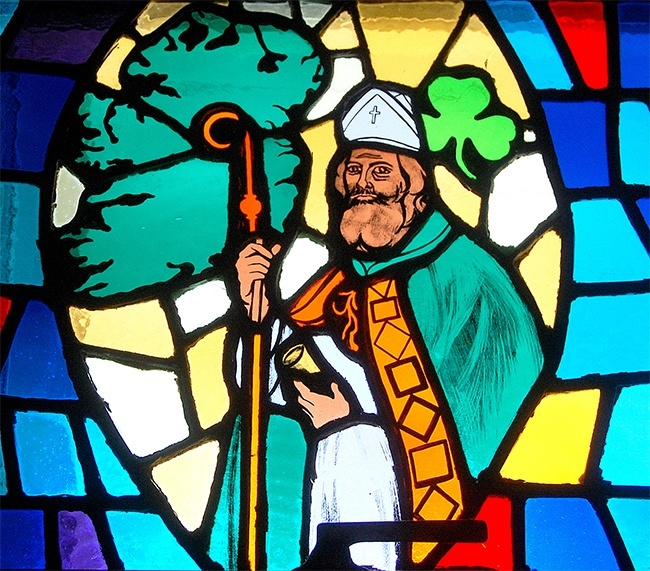
Photographer: JIM DAVIS | FC
St. Patrick is featured in a stained-glass window at St. Gabriel Church, Pompano Beach.
And you'll find lots of them in South Florida, a longtime mission field for Ireland. They’ve built parishes from the ground up. They’ve fed the poor and fought for the oppressed.
They’ve also celebrated, counseled and consoled countless South Floridians. That, as they’ll tell you, is among their specialties.
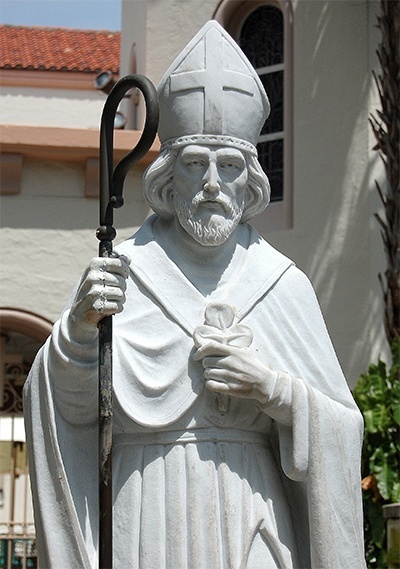
Photographer: JIM DAVIS | FC
Statue of St. Patrick at St. Patrick Church, Miami Beach.
Scan the lists of priests in the dioceses of Florida � especially Miami, Venice and Palm Beach � and you'll run across a host of lilting Irish names like Shea, Delaney, O'Dwyer, Gallagher and Quilligan. They are the heirs and products of centuries of Celtic faith, plus dogged recruitment for a region that desperately needed them.
Self-effacing
They’ve worked with cheer, charm and toughness, but not with conceit. So self-effacing are the Irish priests, most avoided being quoted. And even those who did consent added a request: not to be featured too prominently.
"I don’t want to star in this, in any way, shape or form," said Msgr. Noel Fogarty, who helped bring dozens of priests from Ireland. "I don’t want it to seem like we did everything here, and that none of the other ethnic groups did anything."
But it goes even further than that, said Msgr. Vincent Kelly, pastor at St. John the Baptist in Fort Lauderdale. It's more like humility, training others and pushing them forward.
"None of us is really worthy to be in the priesthood," said Msgr. Kelly, also supervising principal at St. Thomas Aquinas and Cardinal Gibbons high schools in Fort Lauderdale. "But we enter with our human limitations and make a contribution as best we can."
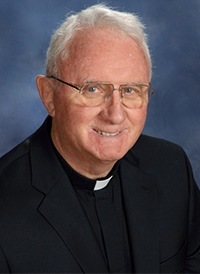
Photographer: FILE PHOTO
"None of us is really worthy to be in the priesthood," says Msgr. Vincent Kelly, pastor of st. John the Baptist Parish in Fort Lauderdale and supervising principal at both St. Thomas Aquinas and Cardinal Gibbons high schools in Fort Lauderdale.
Their forebears are honored as well. Statues of St. Patrick grace Nativity Parish in Hollywood, St. Joan of Arc in Boca Raton, and of course St. Patrick on Miami Beach. So does a window at St. Gabriel Church, Pompano Beach. And St. Kieran Parish in Miami was named for a learned medieval saint who founded a famed seminary in Kilkenny.
Irish essence
"The Church today in South Florida wouldn’t be near as flourishing as it is, if it weren't for Irish priests," said Father Jerry Singleton, pastor of St. Anthony Church, Fort Lauderdale, and a 48-year veteran here. "It's their friendly nature and their ability to rally people behind them."
The priests share with other Irish a talent for storytelling, which works well for homilies. And they leaven their toughness with charm and humor.
"They're good managers, successful at running parishes," said Father Anthony Mulderry, pastor of St. Gabriel Church, who has served in South Florida since 1969. "They're also warm and fuzzy and present to the people. That's very important."
Msgr. Kelly echoed his statements. "When you ask about Irish influence, everyone looks at the buildings, but it's not that. It's the passion, the warmth that they bring to the priesthood. And the vulnerability at funerals and weddings and celebrations. We're sharing the journey with the people in every perspective."
A missionary spirit
Florida's Irish heritage starts, of course, in Ireland. Catholic practice revived after religious emancipation in 1828. After political freedom in 1922 ended seven centuries of English rule, faith and nationalism blended to cause a surge in outreaches to Asia, Africa and America.
"It's an old tradition of service, a missionary spirit," said Church historian Father Michael McNally, pastor of St. Mark the Evangelist Parish in Fort Pierce. He said that drive crested from 1920 to 1970. And they were sorely needed in a state that grew tremendously � from one diocese to seven just since 1940.
Father Thomas Foudy remembers that even his family outhouse in Ireland had magazines from two or three religious orders. His family said the rosary every night and prayed for missions.
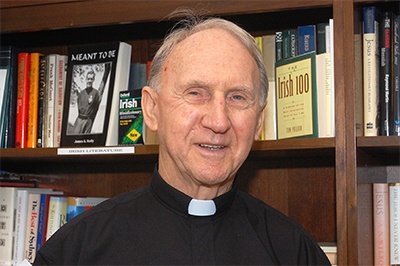
Photographer: JIM DAVIS | FC
Father Jerry Singleton, pastor of St. Anthony Church, Fort Lauderdale, says "The Church today in South Florida wouldn�t be near as flourishing as it is, if it weren't for Irish priests."
To train the many idealistic young men, eight seminaries were founded in Ireland before 1860, Father McNally said. At one time, 17 seminarians hailed from Msgr. Kelly's hometown of Kilrush, County Clare.
Father Mulderry said the Miami Diocese brought in nine priests just in 1967. Perhaps half of all priests in South Florida from the early 1960s to the early 1970s were Irish. And as late as 1989, according to the Sun Sentinel, church officials counted at least 58 Irish-born priests in the archdiocese and another 26 in the Palm Beach Diocese.
Other states sought Irish priests, too: Texas, Kansas, California, Montana, Mississippi, New Jersey. So did other English-speaking countries including New Zealand and South Africa. Diocesan scouts descended on the seven mission seminaries every spring, when students were deciding which nation to choose.
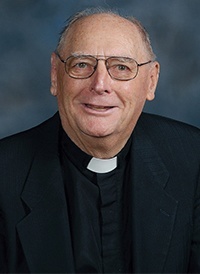
Photographer: FILE PHOTO
Msgr. Noel Fogarty, now retired, recruited priests from Ireland to work in the Archdiocese of Miami from 1962 to 1971.
Knowing Irish idealism, he made vastly different offers: the challenge of hard work and the opportunity to spread the faith and save souls.
How did the monsignor do? "We more than held our own," he said laconically: At one time, he had 55 seminarians signed up to come to South Florida.
Father Foudy remembers Msgr. Fogarty's pitch. "He said it would be a lot of hard work in a growing diocese, and unless you were prepared to work, forget about Miami." He came anyway.
Culture shock
South Florida, though, was a multi-level shock to the young Irishmen: culture shock, climate shock, geographic shock at the growing cities and long distances.
Sometimes, adjustment meant literal weathering. Father Richard Murphy, now pastor of Holy Cross Parish in Vero Beach, walked out of Miami International Airport in August 1965. "Wouldn't you think they'd turn that damn heat off?" he griped to a friend. The friend replied: "We're outside!"
Sometimes it was assignment shock. Msgr. Fogarty, who came here in 1957, was tasked immediately to Notre Dame Academy � a girls' school � teaching six classes a day.
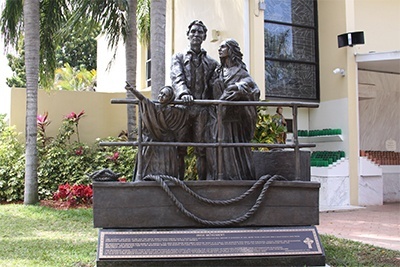
Photographer: JONATHAN MARTINEZ | FC
In February, 2007 this statue in honor of Irish immigrants to south Florida was erected on the grounds of Nativity Parish in Hollywood. Its pastor for the past 28 years has been an Irishman, Father Patrick Murnane.
To make it easier for those who followed, he founded a two-week orientation course. It dealt with everything from food to geography to marriage laws to vocabulary, like gas versus petrol. The priests also learned to moderate their Irish brogue.
They may have chafed at the heat, but they glowed in the warmth of the laity. They remember quiet, church-linked social lives. Every parish, it seemed, had a Catholic Youth Organization. Many also had basketball leagues and Knights of Columbus councils.
"What impressed me the most was the volunteerism � they were prepared to do anything," said Father Murphy. "And they were very accepting. They'd invite us over for dinner. They made it a lot easier for us guys."
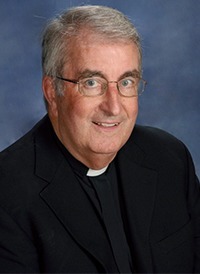
Photographer: FILE PHOTO
"You can have big parades and bring thousands together, but it's the little things that people need � a smile, a kind word," says Father Edward Michael Kelly, pastor of St. Elizabeth Ann Seton Church, Coral Springs.
Father Martin Cassidy remembers serving as a young priest at Immaculate Conception in Hialeah, visiting every home in the parish. He said he loved the up-close contact.
"And I knew all the Fuller Brush men in town," added Father Cassidy, now retired in Lauderdale-By-The-Sea. He'd lunch with them at a Royal Castle, enjoying a burger and a glass of milk.
Father Seamus Murtagh, former chancellor of the Diocese of Palm Beach, said he was affected all his life from his early work at St. Clement Parish in Fort Lauderdale and the vigorous building boom in the Miami archdiocese.
"It was a powerful experience, and it blessed me all my life," said Father Murtagh, now semi-retired in Palm Beach Gardens.
Helping the downtrodden
Another Irish trait: fending for the disadvantaged. Coming from a poor nation that had only recently won independence gave the priests a drive to help the less-fortunate in South Florida.
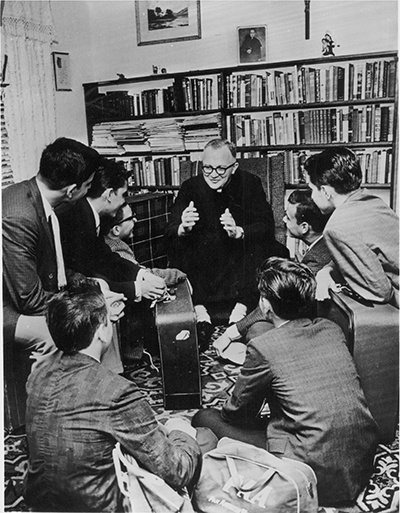
Photographer: FILE PHOTO
An Irishman, Msgr. Bryan O. Walsh, was instrumental in organizing the Pedro Pan exodus of 14,000 Cuban children from the island to the U.S. in the early 1960s.
Msgr. Bryan O. Walsh championed the massive Peter Pan program that brought more than 14,000 Cuban children to South Florida under archdiocesan care. He ran Catholic Charities, one of the largest Catholic social service agencies in the U.S. He also organized aid to Haitians fleeing the Duvalier regime, as well as Cubans in the Mariel boatlift, both in the 1980s.
In 1963, the monsignor condemned segregation as a sin, a statement that became part of the charter for Miami's Community Relations Board. He also reached out to Jewish leaders, a friendship that helped to bring about Pope John Paul II's 1987 dialogue with them in Miami. And he hosted the installation of a Holocaust memorial statuette at the archdiocesan Pastoral Center.
In Broward, Father John O'Looney reached near-legendary status over four decades. Coming in 1928, he was the longtime pastor at St. Anthony in Fort Lauderdale. He also built St. Sebastian and helped to found Holy Cross Hospital, which came under the care of the Sisters of Mercy. And he founded Central Catholic High School, now known as St. Thomas Aquinas.
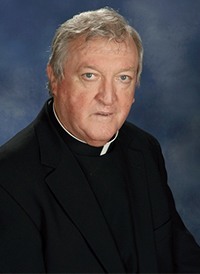
Photographer: FILE PHOTO
Father Thomas Foudy, pastor of St. Coleman Parish in Pompano Beach, once debated a scholar in Washington, D.C., who criticized Florida priests for not fretting over theology or Bible studies. His reply: "You have to see what priests are doing there: schools, hospitals, taking care of the latest emergency."
Then there were the "Three Barrys," as Father McNally's book, "Catholicism in South Florida, 1868-1968," calls them. They included Bishop Patrick Barry, chief shepherd of Florida from 1922 to 1940; Msgr. William Barry, founding pastor of St. Patrick Church on Miami Beach; and Sister Gerald Barry, an Adrian Dominican sister who founded Barry College (now Barry University) in Miami Shores.
"I've heard her called the closest to a female cardinal," Father Foudy said. "If you needed a school staffed by nuns in the Midwest, you'd come to her with hat in hand. She had sisters educated at Harvard, Yale and Princeton before it was popular."
Serving the poor
Other priests became specialists in serving migrant farmworkers. Father Cassidy served for years with growers in the Sebring and Okeechobee areas. Father Singleton worked with migrants in Immokalee and Indian River County.
"In Ireland, where the people were poor, sacrifice was taken for granted," Father Singleton said. "So serving the poor was second nature."
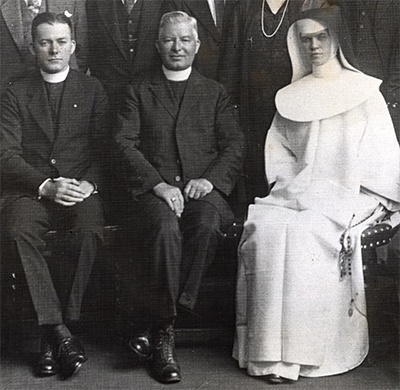
Photographer: FILE PHOTO
Shown in this 1926 photo, from left: Msgr. William Barry, founder of St. Patrick Parish, Miami Beach, and of the Florida Catholic newspaper; his brother, the fifth bishop of St. Augustine, Bishop Patrick Barry, who died in 1940; and their sister, Catherine (Mother Mary Gerald), superior of the Adrian Dominican Sisters, who founded Barry College in 1940, the first Catholic college for women in the state of Florida.
Nor did the Irishmen simply dole out help aloofly. Father Cassidy, who once presided over the Florida Citizens' Council on Farm Labor, tearfully remembers a scene from decades ago. Visiting a galvanized hut in Indiantown, he saw a sick, elderly man working in 100-plus heat.
"There was no nurse, no one to bring him a glass of water," he said with a catch in his throat. "I took him to a hospital."
These spiritual sons of St. Patrick, then, ran ministries of mercy and compassion long before Pope Francis preached them in Rome. Father Foudy, a former moral theology teacher at St. Vincent de Paul Regional Seminary in Boynton Beach, said he once debated a scholar in Washington, D.C., who criticized Florida priests for not fretting over theology or Bible studies.
Father Foudy's reply: "You have to see what priests are doing there: schools, hospitals, taking care of the latest emergency."
Twilight of the Irish
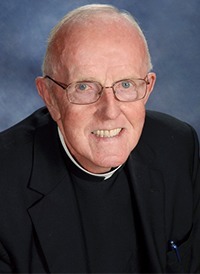
Photographer: FILE PHOTO
Father Anthony Mulderry, pastor of St. Gabriel in Pompano Beach, keeps a weekly golf date with other Irish priests in Broward. The youngest among them is about 65. "The Irish invasion is finished," he says.
"My whole priesthood has been a blessing," he said. "I've been enriched by all the people I've met. Even in retirement, I have things to do."
Others read, walk, have dinner with old friends, and visit Ireland to see the many nieces and nephews that each seems to have in abundance. A half-dozen also keep a weekly golf date together in Broward.
That golfing circle is a clear sign of the future. Father Mulderry once looked around and saw that the youngest was about 65. "The Irish invasion is finished," he said.
Trends in Ireland itself pretty much enforce that: secularism, smaller families, anti-institutional attitudes. Most seminaries there have closed.
Yet the priests seem uninclined to mourn their twilight in South Florida. They note that Hispanic, Haitian and homegrown priests are taking their place, matching the area's demographic shift. Father Murphy even sees similarities between Haitian priests and their Irish brothers in their "industrious and enthusiastic" habits.
"We came when we were needed," he said. "Now we have a strong diocese with strong parishes. I thank God for that."
Msgr. Fogarty agreed. "The mission has been fulfilled. You're a success when you're no longer needed."
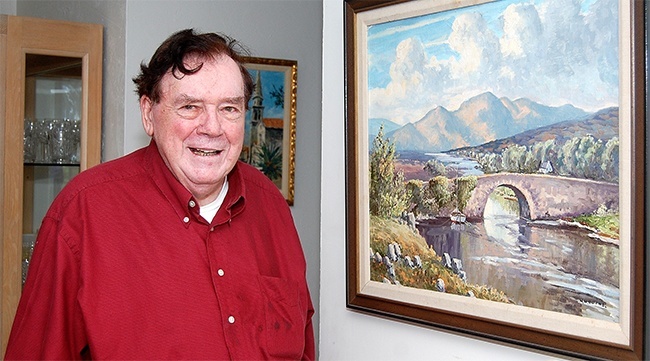
Photographer: JIM DAVIS | FC
Father Martin Cassidy shows a painting of an Irish countryside hanging in his retirement home in Lauderdale-By-The-Sea.


Comments from readers
The Archdiocese of Miami owes a great debt to the Emerald Isle as do I.
Go raibh maith agaibh! Thank you all!